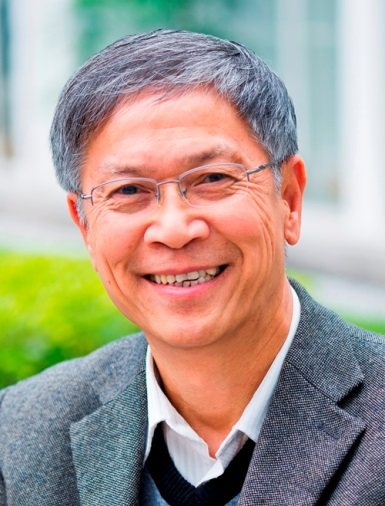Invited Speakers
1 Prof. Julien Clinton Sprott, University of Wisconsin, USA

Web site: http://sprott.physics.wisc.edu/sprott.htm
Talk Title: Ergodicity in Chaotic Oscillators
Abstract: Most common chaotic systems have a finite range of initial conditions over which the chaos occurs, and the long-time orbit visits an even smaller subset of that space, usually a set of measure zero when the system is dissipative with a strange attractor. I will describe simple systems in which the orbit visits the entirety of the space and does so with a Gaussian probability distribution, even in the presence of dissipation. Thus every initial condition is not only in the basin of attraction, but it lies on the attractor which is a multifractal. Despite the dissipation, these systems are time-reversible with a repellor that is coincident with and overlaps the attractor. Furthermore, these systems can be constructed so they have no equilibrium points, and thus the attractor is "hidden" by the usual definition. They violate every preconceived notion of how a respectable strange attractor should behave, and they invite further detailed study.
2 Prof. Guanrong Chen (陈关荣), City University of Hong Kong, China

Web site: http://www.ee.cityu.edu.hk/~gchen/
Talk Title: A Tour of Chaos: Generalized Lorenz Systems Family
Abstract: This talk presents an overview of the generalized Lorenz systems family, which includes the classical Lorenz system and the relatively new Chen system as special cases, with infinitely many related but non-equivalent chaotic systems in between. The talk will explain the similarities and differences of the Lorenz system and the Chen system, comparing their complex dynamics and topological features. Finally, the talk will describe the parameterized generalized Lorenz systems family and generalized Lorenz canonical form, which encompass many typical Lorenz-type chaotic systems in a unified framework.
3 Prof. Michael Tse (谢智刚), City University of Hong Kong, China

Web site: https://www.cityu.edu.hk/stfprofile/chitse.htm
Talk Title: Modeling of COVID-19 Spreading with Human Migration Data
Abstract: The 2019 New Coronavirus Disease (COVID-19) outbreak began to occur and escalate in a special holiday period in China (about 20 days surrounding the Lunar New Year), during which a huge volume of intercity travel took place, resulting in outbreaks in multiple regions connected by an active transportation network. Thus, to understand the COVID-19 spreading process in China, it is essential to examine the human migration dynamics, especially between the epicentre Wuhan and other Chinese cities. A new Susceptible-Exposed-Infected- Confirmed-Removed (SEICR) model with consideration of intercity travel and active intervention is proposed for predicting the spreading progression of COVID-19. The model takes into account the known or reported number of infected cases being fewer than the actual number of infected individuals due to insufficient testing. The model integrates intercity travel data to track the movement of exposed and infected individuals among cities, and allows different levels of active intervention to be considered so that realistic prediction of the number of infected individuals can be performed.
4 Prof. Shujun Li (李树钧), University of Kent, UK

Web site: http://www.hooklee.com
Talk Title: User Privacy Protection in Cyber-Physical World as a Complex Network Problem
Abstract: Nowadays we are living in a highly connected cyber-physical world, and we are increasingly depending on others, including organisations such as online service providers and other people, to live our lives and do businesses. As a result, we are disclosing our personal data with many parties online and in the physical world, leading to privacy concerns and genuine leakages of personal information to wrong hands. In this talk, the speaker will look at the user privacy protection problem from a complex network angle, and introduce his ongoing work on building a computational graph-based model to help capture how people share personal data with organisations and other people, in order to support research and development of more user-centric privacy solutions.
5 Dr Murilo Baptista, University Aberdeen, UK

Web site: https://www.abdn.ac.uk/icsmb/people/profiles/murilo.baptista
Talk Title: Zooming into Chaos for a Fast, Light and Reliable Cryptosystem
Abstract: Motivated by today's huge volume of data that needs to be handled in secrecy, there is a wish to develop not only fast and light but also reliably secure cryptosystems. Chaos allows for the creation of pseudo-random numbers by low-dimensional transformations that need to be applied only a small number of times. These two properties translate into a chaos-based cryptosystem that is both fast (short running time) and light (little computational effort). The reliability of security in a chaos-based cryptosystem is sustained by the exponentially fast decay of the correlation of points in a chaotic trajectory. However, chaos is deterministic, and as such, a sufficiently long observation of the trajectory or its symbolic encoding can reveal its past and future evolution, thus breaking security. That is a known weakness of chaos in cryptography. However, this vulnerability can be compensated by another still not much explored peculiar property of chaos. Look at the less significant digits of a chaotic trajectory and surprisingly the information content of past and future vanishes exponentially fast. What we propose here is an enhanced chaos-based cryptosystem that uses the ``deep-zoom'' transformation on the top of a chaotic map to improve the reliability of security, but without compromising on the speed and weight of the cryptosystem. We use low-dimensional chaotic maps to quickly generate numbers that have little correlation, and then we quickly (``fast'') enhance secrecy by several orders (``reliability'') with very little computational cost (``light'') by simply looking at the less significant digits of the initial chaotic trajectory. This talk demonstrates this idea with rigour, making a comprehensive ergodic characterization of this procedural strategy to create pseudo-random numbers that can sustain a fast, light and reliable cryptosystem.
6 Prof. Chao Xu (许超), Zhejiang University, China

Web site: https://person.zju.edu.cn/xu
Talk Title: Turbulent Flow Motion Estimation Using Machine Learning Techniques
Abstract: In this talk, I would like to introduce machine learning techniques in processing visualization data from particle image velocimetry (PIV), which is a typical visualization approach in experimental fluid mechanics. As it is well known that fluid-structure interaction is widely existing in the nature of biological swimming and flight phenomena, but locomotion here (how propulsion is generated) is challenging to model and then applied later in building various artificial systems such as bio-inspired robots. Besides the first principle models such as solving the nonlinear Navier-Stokes (NS) equations, experiments as alternative approach which play a critical role in fluid mechanics, such as PIV. In recent years, there are increasingly many novel techniques arising in the communities of computer vision, machine learning as well as computational imaging, etc. which combine the computing power with advanced algorithms to process the visual data. In this work, we tried to apply those state of the art methods to the area of visual computing for fluids and of course many challenges would be expected. For example, how can essential physics (incompressibility, etc.) be guaranteed while machine learning techniques are applied? To solve these problems, we studied fusion frameworks to leverage the fluid physics as well as the visualization data, where assimilation using variations, physics-informed deep learning, are proposed. In the results, we demonstrate that our proposed methods could not only greatly improve the fluid velocity reconstruction accuracy but also the computing efficiency.
7 Prof. Jun Ma (马军), Lanzhou University of Technology, China

Web site: https://www.lut.edu.cn/info/1153/63392.htm
Talk Title: How to Build Functional Neurons?
Abstract: Biological neurons can handle and encode biophysical signals completely, and their self-adaption gave potential guidance to design smart artificial neurons by incorporating some physical components into the micro circuits. Considering the physical properties, the memristor, Josephson junction, thermistor and phototube are utilized to build functional neural circuits, in which the electromagnetic induction, external magnetic field, temperature and optical signal can be encoded for generating equivalent channel current in the circuits. Furthermore, hybrid synapse can be obtained to reproduce the synaptic plasticity when some of these functional components are combined to connect the coupling channels. These results provide possible clues to design more intelligent neural circuits, and they can also present guidance to know the biophysical mechanism of signal processing in biological neurons.
Key words: synaptic plasticity; memristor; Josephson junction; thermistor; photocell
8 Prof. Zuguo Yu (喻祖国), Xiangtan University, China

Web site: http://daoshi.xtu.edu.cn/index.php?id=782
Talk Title: Some Applications of Fractal and Multifractal Analyses to Complex Networks
Abstract: The fractality of complex networks has attracted much attention and been investigated extensively in past 15 years. As a generalization of fractal analysis, multifractal analysis (MFA) is a useful tool to systematically describe the spatial heterogeneity of both theoretical and experimental fractal patterns. Box-covering with minimum number of boxes for calculating the fractal dimension of complex networks is a NP-hard problem. The computational complexity of algorithms for MFA of complex networks is much higher than that of algorithms for fractal analysis of complex networks. However, the existing sandbox MFA algorithm is still computationally expensive, so far it has only been applied to small-scale complex networks of the size of about tens of thousands of nodes. It becomes challenging to implement MFA algorithms for large-scale complex networks with tens of millions of nodes or more. In this talk, I will introduce some algorithms for fractal and multifractal analyses of complex networks, and some applications of fractal and multifractal analyses to complex networks.
9 Prof. Lixiang Li (李丽香), Beijing University of Posts and Telecommunications, China

Web site: https://scss.bupt.edu.cn/info/1063/1187.htm
Talk Title: A New Chaotic Structure for Creating New Chaotic Maps with Large Parameters Range
Abstract: Chaotic systems are widely used in various fields due to their chaotic characteristics. We propose a new, simple and effective universal chaotic structure. The existing traditional one-dimensional chaotic maps, such as Logistic map, Sine map, Chebyshev map, Tent map, can be applied to the proposed chaotic structure to generate new chaotic maps. Performance analysis show that compared with traditional one-dimensional chaotic systems, the corresponding new chaotic maps under this new structure have larger range of chaotic parameters, excellent chaotic effect, and large key space. They can enhance the security of chaotic systems, and exhibit higher resilience against reconstruction attacks and brute force attacks, which are important features when applied to the field of encryption.
10 Prof. Jiu Ding, The University of Southern Mississippi, USA

Web site: https://www.math.usm.edu/jding
Talk Title: Computational Ergodic Theory from Stanislaw Ulam and Tien-Yien Li
Abstract: In a discrete chaotic dynamical system, the eventual distribution of the orbits of almost all initial points is usually determined by physical measures, in particular absolutely continuous invariant probability measures. The density of such a measure is a fixed point of the corresponding Frobenius-Perron operator. Although the existence of a fixed density can be established theoretically in some cases, it may not be easily obtained explicitly in ergodic theory and its applications. Stanislaw Ulam proposed the first numerical scheme to compute a fixed point of the Frobenius-Perron operator for interval maps in his 1960 book A Collection of Mathematical Problems, and conjectured the convergence of the method. Tien-Yien Li developed the same method independently in 1976 and proved Ulam's conjecture for the Lasota-Yorke class of interval maps. Computational ergodic theory initiated with their pioneering work. This talk will go over the basic idea of their contributions and subsequent developments in the past four decades. This talk is dedicated to the memory of Tien-Yien Li.











